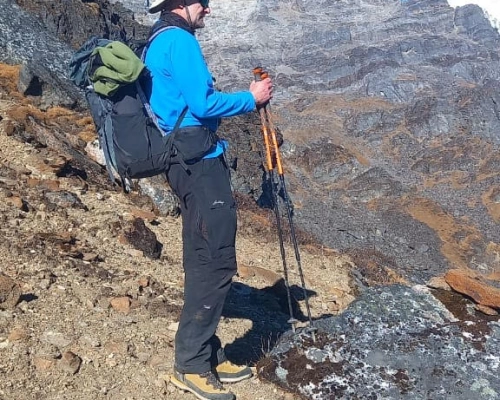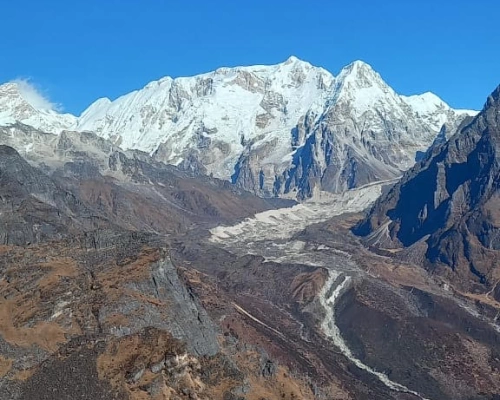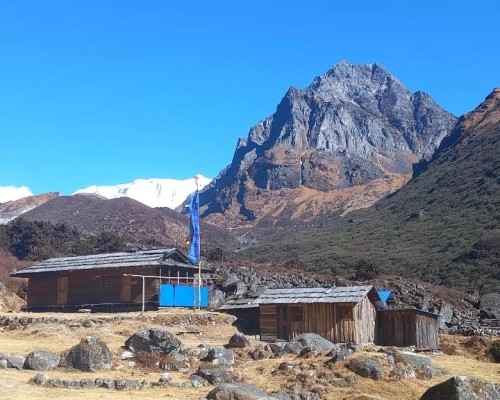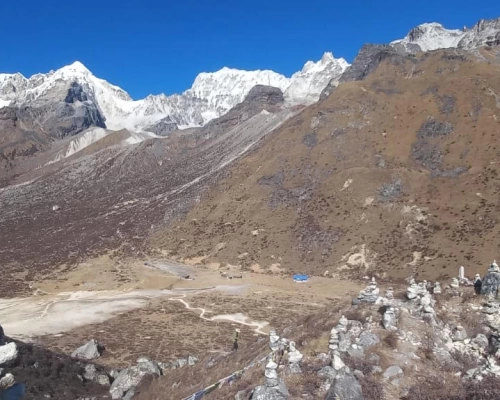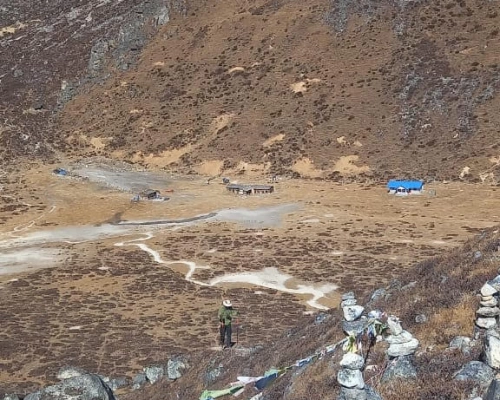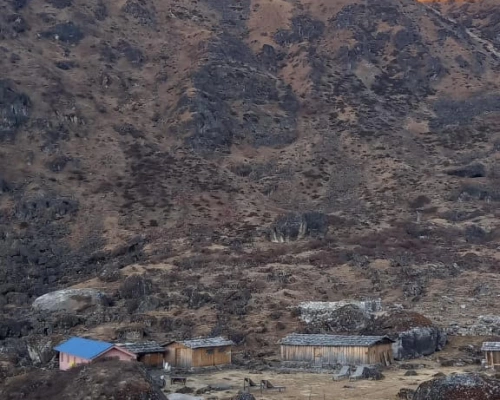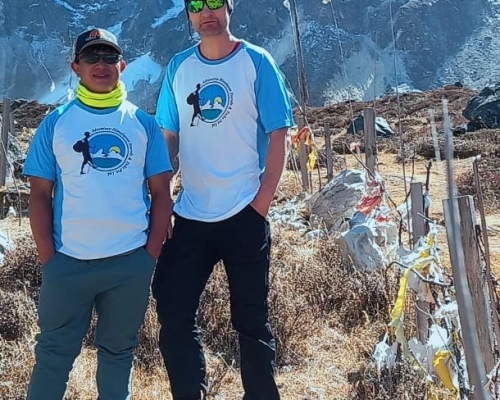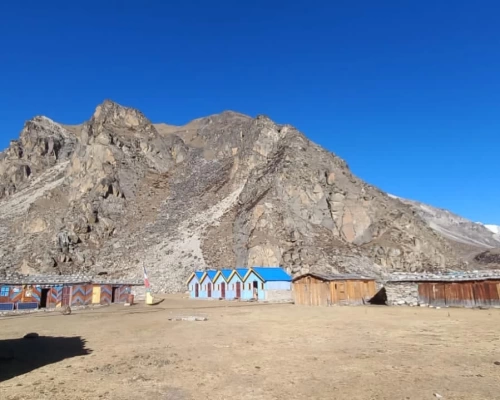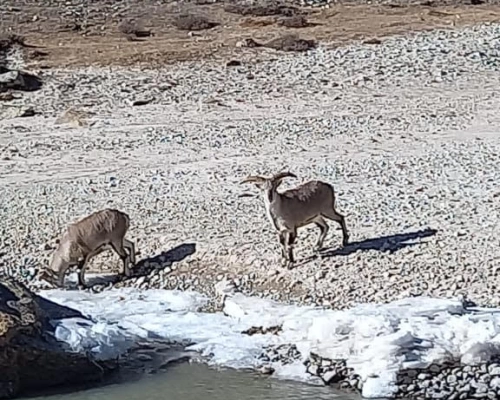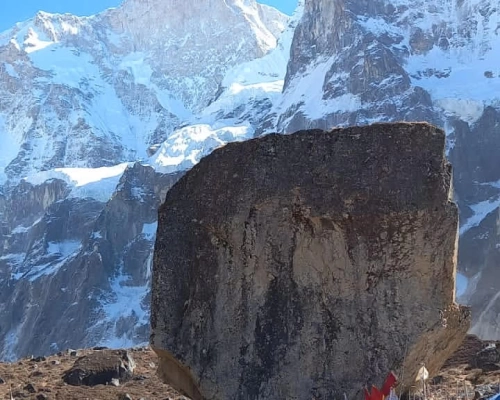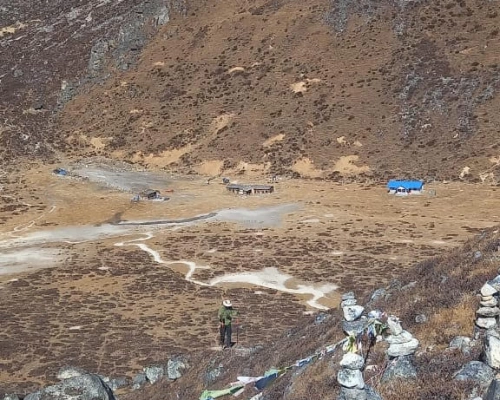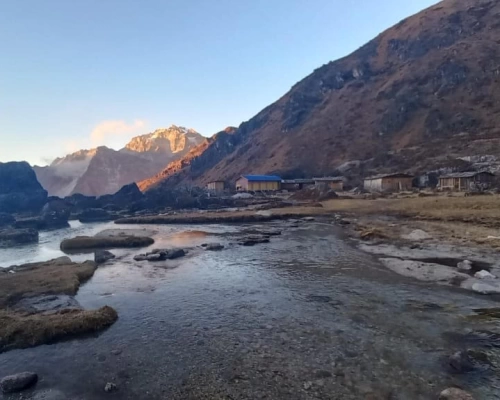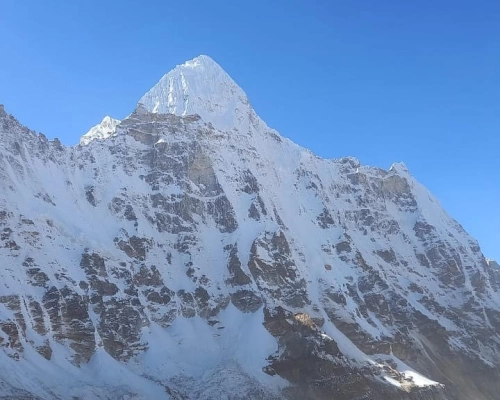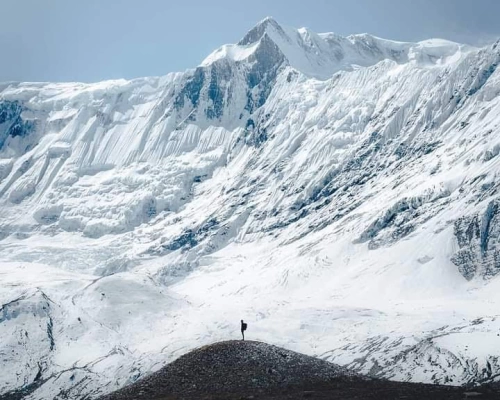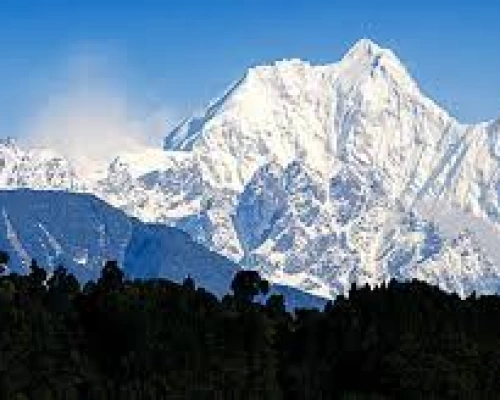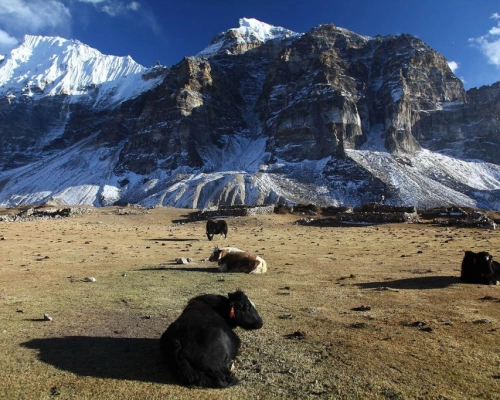Kanchenjunga North and South Trek is an amazing trekking route in the Nepalese Himalayas that offers an adventurous journey to the two magnificent base camps of the world’s third highest mountain, Mt. Kanchenjunga (8,586m). This hike is less crowded as compared to some of the other popular trekking trails in Nepal, such as the Everest Base Camp and Kala Patthar Odyssey - 14 Days, Annapurna Base Camp Trek, or Langtang Valley Expedition, which provide a more remote and pristine Himalayan touch.
Also known as the Kanchenjunga Circuit Trek, the thrilling journey to Kanchenjunga North and South takes you to the lap of glorifying Mt. Kanchenjunga as you traverse through the stunning Kanchenjunga Conservation Area lying in the beautiful Arun Valley at the eastern part of Nepal as the border to Sikkim (India). This one of the highly protected lands offers never-ending varying landscapes, immersing culture, and stunning panoramic views of the Himalayas.
Further, the Kanchenjunga North and South trekking trail, covering almost 220 km, is known for its abundance of unique flora and fauna, waterfalls, and water streams at a contrasting beauty of snow-capped peaks in the Upper Himalayas, inhabited by the diverse ethnic communities of Sherpa, Rai, Limbu, Tamang, Gurung, and Bhote, along with the most admired natives of the Himalayas, Sherpa, for their excellent adaptation to the mountainous environment, adding much to the cultural and natural indulgement.
Hence the Kanchenjunga Circuit Trekking is a once-in-a-lifetime high-altitude raw Himalayan adventure offering a brief insight into the customary life in the Himalayas while trekkers and travelers mark victory over the south and north base camps of the third largest peak globally, Mt. Kanchenjunga (8,586m) at an altitude of 5,515 m/17,090 ft and 5,364 m/17,598 ft, respectively.
What makes the journey to Kanchenjunga North and South an epic Himalayan Excursion?
The Kanchenjunga North and South Trek, the adventurous journey to Nepal’s second-highest peak and the third largest in the globe, is renowned for its remote and challenging routes, spectacular natural beauty, cultural and religious heritages, magical mountain views, swakiness in biodiversity, spiritual significance, legal complexity, and emphasis on environmental sustainability.
While Kanchenhinga is a mountain of sheer beauty, with its shimmering glaciers radiating from its summits showcasing its glories, the voyage here is best done with the native guides possessing a deeper knowledge of the region's culture, customs, and tradition, along with their profound familiarity with the route, adding much to the Kanchejung alpine rambling to be an epic nature and cultural excursion side by side as assured by:
The legendary mountain views on the way to North and South Base Camp of Kanchenjunga
The trek to Kanchenjunga North and South is noted for its splendor of mountain views, providing a chance to marvel at some of the most majestic and imposing snow-clad peaks in the Himalayas. From the towering mass of Kanchenjunga itself to the alluring and rugged peaks of Rathong, Jannu, and Kabru, the visual feast is unmatched as far as the eyesight can reach.
The hiking route to the North Base Camp of Kanchenjunga, or Pangpema, is mostly dominated by the awe-inspiring and close view of its massive north face, Jannu (Kumbhakarna), Wedge Peak, Tent Peak, and several other unmanned snow-capped ranges that add to the dramatic skyline as you move closer and closer to the North Base Camp.
While the quest to the South Base Camp of Kanchenjunga (Oktang) offers the panoramic grandeur of Kanchenjunga’s south face, followed by Rathong, Kabru Ranges, and Talung Peak, which come together with the pristine glaciers, this long and adventurous expedition to the Kanchenjunga North and South is a truly epic and unforgettable experience.
The spiritually cleansing route to the sacred mountain of Kanchenjunga
The Kanchenjunga is revered as a holy mountain by local communities, especially Rai and Limbhu, as the abode of the deity guarding the Kanchenjunga region, inspiring references and spiritual reflection among those journeying towards the circuit. Summiting the true peak of Kanchenjunga is yet restricted due to a promise made to Tashi Namgyal, the Chogyal of Sikkim, reflecting the cultural and religious importance of the mountain peak.
The route to the Kanchenjunga Circuit is remote and tranquil, far away from the chaotic modern life, offering ample opportunities for meditation and self-reflection, passing by several lakes and rivers believed to be divine by locals. Further, the trekking trail to the Kanchenjunga North and South Base Camp lets trekkers and travelers have a sensational encounter with various religious practices and cultural traditions, depending on the time of visit.
Therefore, the trekking voyage to Kanchenjunga North and South Base Camps is considered to be spiritually healing, more than just a physically pleasing or challenging jaunting imbued with cultural and spiritual significance, along with a chance to connect with nature, engage in spiritual practices, and gain insight into the region’s treasure of cultural traditions, resulting in a transformative and enriching experience encouraging mindfulness and a broader perspective of life.
The untainted off-the-beaten Himalayan Trekking Route
The Upper Himalayas hiking route to the Kanchenjunga Circuit or North and South Base Camp boasts an off-beaten-path adventure. Located in a rural area in eastern Nepal, in proximity to the border with Sikkim, India, along with the trails, several unique characteristics set this trackaway apart from more popular Himalayan treks.
The trail passes through numerous isolated villages with limited infrastructure, featuring comparatively fewer tea houses, lodges, and amenities. In addition, the Kanchenjunga region is a restricted area, making it accessible to only a countable number of trekkers and travelers requiring special permits and the accompaniment of a registered guide or porter, which may add to the trek challenge but also to the authenticity.
Therefore, due to its remoteness, permit requirements, and demanding nature, the Kanchenjunga Circuit attracts fewer trekkers, guaranteeing less crowded trails, quieter campsites, and a more tranquil trekking experience, enhancing the sense of wilderness, raw Himayalan involvement, and personal connection with nature.
The ever-smiling and welcoming locals of the Himalayas
There is a famous saying: “People visit Nepal for the Himalayas but return for its local people” reason that trekkers, mountain climbers, and travelers consistently get to meet with the locals from the Himalayas with genuine warmth and hospitality, granting a home away from the home environment even during the high Himalayan expedition to the Kanchenjunga North and South.
The villages dotted along the Kanchenjunga Circuit primarily consist of Sherpas, Limbu, Rai, and other ethnic communities of Nepal known for their friendly and accepting nature despite the remote and often harsh living conditions in the Himalayas, giving you easy access to experience the authentic lifestyle and traditions of the Himalayan people as you get to spend nights in local lodges and tea houses opened by natives.
These tea houses not only provide you with a comfortable shelter but also the tales of the mountains, their lovers, and a glimpse into the villagers' daily lives. On the way to the Kanchenjunga North and South Base Camp, trekkers can enjoy traditional Nepali delicacies spiced up by a sense of community and generosity that transcends cultural barriers.
The challenge and adventure of reaching the North and South Base Camp of Kanchenjunga
The Himalayan trip to the Kanchenjunga North and South Base Camp is usually not recommended for the faint of heart. Both are situated at high altitudes, with the South Base Camp at around 5,143 m/16,870 ft and the North Base Camp at around 5,180 m/16,994 ft. Hiking to such an elevation poses significant challenges due to the decreased amount of oxygen that can cause altitude mountain sickness (AMS) or other altitude-related illnesses.
In addition to these, rugged terrain, high mountain passes, and unpredictable weather also present a formidable challenge, even for veteran mountaineers, climbers, and expeditors, demanding notable physical stamina, mental resilience, and thorough acclimatization.
Nonetheless, overcoming these challenges is extremely rewarding, adding much to the profound sense of achievement and adventure that may involve crossing glaciers, navigating through rocky terrain, and some steep ascends and descends, initiating the use of crampons, ice axes, and ropes during the adventuresome trek to the Kanchenjunga North and South.
The best 21 Days Itinerary for Kanchenjunga North and South Trek
The 21-day itinerary and route to the high Himalayan expedition to the Kanchenjunga North and South officially begins with an amazingly dare-devil flight from Kathmandu to Suketar or Bhadrapur and a drive to Taplejung after an exploration day in the Kathmandu Valley to appreciate remarkable UNESCO World’s Heritage Sites. Then onward you will make your way through several typical Sekathum, Amjilosa, Gyabla, Ghunsa, Kambachen, and Lhonak, ultimately to Pangempa, the north base camp of Kanchenjunga, at an altitude of 5,515 m/17,090 ft, which is also the highest elevation gain of the entire trip to the Kanchenjunga North and South.
The arrival at the north base camp now indicates the start of the second phase of the Kanchenjunga Circuit Tour to embark on the south base camp, otherwise called Ramche, requiring careful consideration of the route; hence, it is advised to follow the footsteps of your mountain guides, well trained for alpine rambling authorized by the Government of Nepal itself. Nonetheless, the second half, as per the 21-day trek itinerary and route to Kanchenjunga North and South, also provides you with an unparalleled experience that reaches the South Base Camp, Ramche from the North via Ghunsa, Selele Pass, and Tsaram.
From Tsaram, however, begins the retracing hike to the starting point of the overall pilgrimage to the North and South Base Camp of Kanchenjunga, Bhadrapur, which is also the voyage-ending spot with the maximum descending trek from Trongden, Yamaphudin, Khebang, and Hapu Khola to Illam, ensuring an unforgettable odyssey to the Kanchenjunga Himalayas with the perfect blend of natural beauty and cultural encounters in the most unspoiled and mysterious Nepalese Himalayas.
This 21-day itinerary at an affordable package cost with Adventure Himalayan Travels and Treks guarantees a well-balanced ascent to the Kanchenjunga North and South; therefore, it is considered the best and ideal route to traverse the region, allowing ample acclimatization, logistical management, and enhanced trekking involvement to be a must-do during the holidays.
In addition, this trail is also regarded as best for minimizing the risks associated with altitude and fatigue, crafting a more holistic and rewarding adventure. If you prefer a more personalized itinerary, contact us now. We are at your service 24/7.
Kanchenjunga North and South 21 Day Hike Cost
Generally, the cost of a 21-day Kanchenjunga North and South Trek ranges anywhere from USD 2,320 to USD 2,075 with Adventure Himalayan Travels and Treks covering the expenses of crucial pilgrimage logistics such as permits, food, accommodations, Nepalese staff, including government-licensed guides and porters, the necessary alpine hiking equipment, and the necessities for your mountain trip partner, along with their travel insurance.
Regardless, with Adventure Himalayan Travels and Treks, you can achieve the Kanchenjunga North and South Base Camp summit at special group discounts with trek members including more than 10 individuals, which for now is at the standard price of:
- USD 2,320 for 1 pax
- USD 2,175 for 2-3 pax
- USD 2,125 for 4-6 pax, and
- USD 2075 for 6-10 pax
Contact us now for a more sorted budget plan and itinerary to embark on several beautiful Himalayan corners of the world, specifically forged to meet your needs and preferences catering to your niche area.
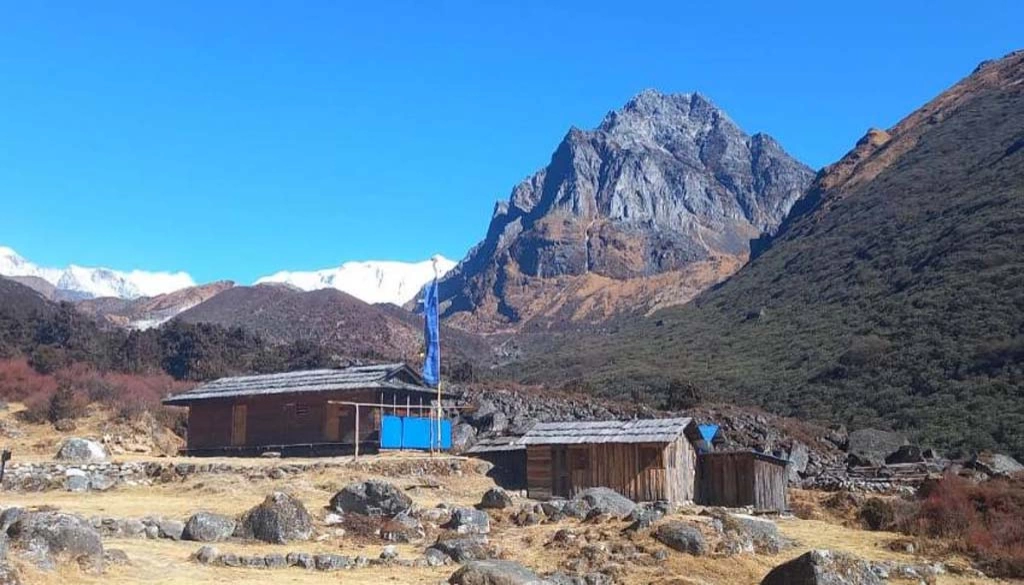
.webp)

